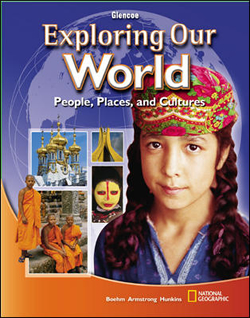Exploring Our World: People, Places, and CulturesChapter 19:
Physical Geography of Africa South of the SaharaWeb Activity Lesson PlansIntroduction
In this chapter, students learned about the physical features of Africa south of the Sahara. Waterways in this area are critical to the survival of the region and its people. The Niger River runs through nine countries in West Africa, including Mali. The Web site for this activity contains maps, photographs, facts, and first-person accounts of life on the Niger River as well as links to other information about Mali. Lesson Description
Students will visit the Oxfam/Cool Planet Web site. Here they will view maps and read information about the Niger River. They will also read one fisherman’s account of working on the Niger River. They will answer questions based on their readings. Instructional Objectives - The learner will be able to locate the country of Mali and the Niger River in West Africa.
- The learner will be able to describe how the river is used by the people of West Africa.
- The learner will be able to predict what threatens the health of the river and how that could impact the region.
Student Web Activity Answers - over 2,500 miles
- The water spreads out into a massive, fertile, inland delta.
- The river provides food, drinking water, and water for farming. It is used by traders to transport crops and goods. It is also used as a means of transportation to travel throughout Mali.
- The numbers of fish are shrinking and the equipment, such as nets and canoes, is more expensive.
- When the river floods, it helps the farmland become more fertile, which in turn helps crops grow.
- pollution, global warming, and population growth; people might lose their jobs, their health could be affected, and people might move away
 | 




